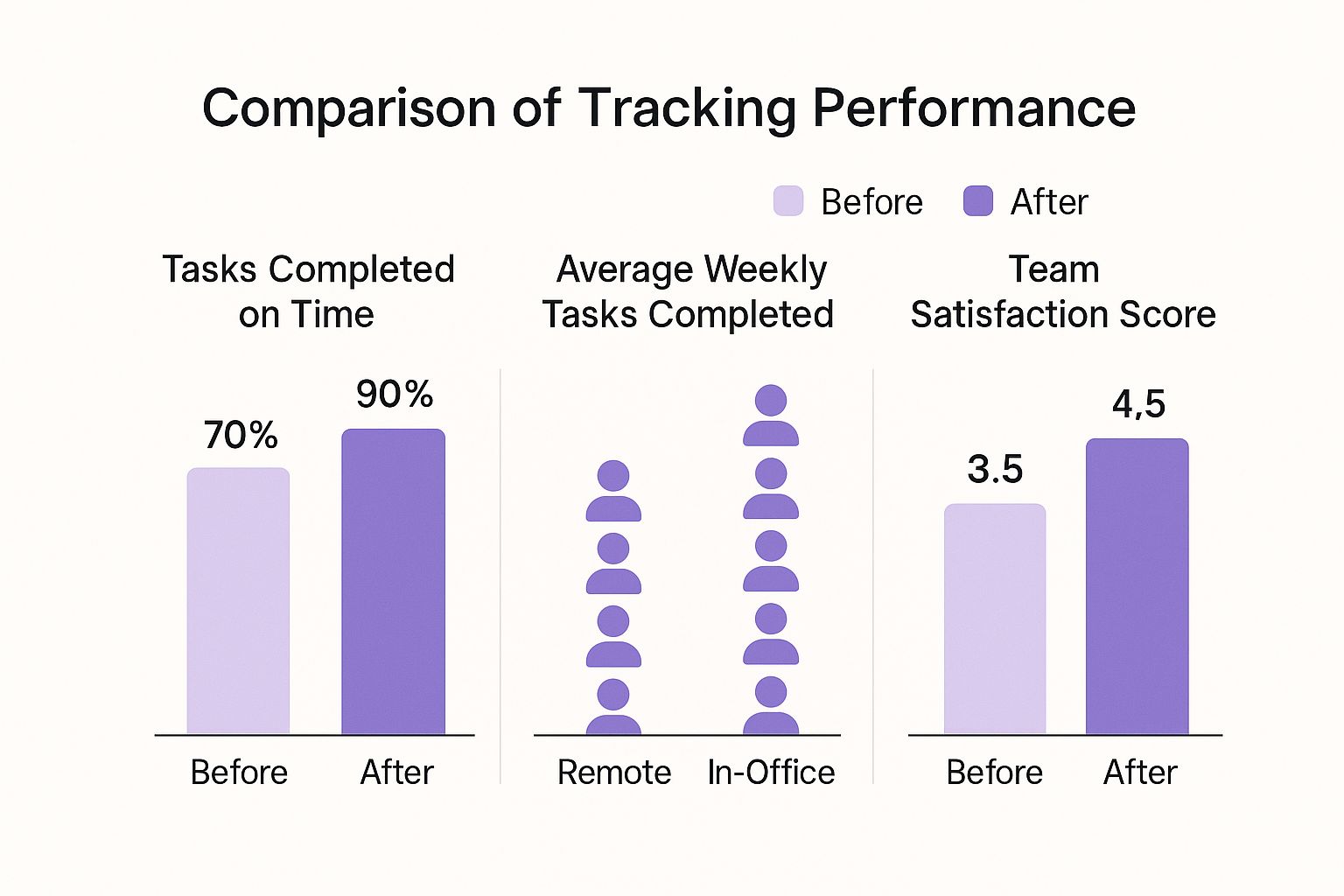
When you're leading a team that isn't in the same room, the old rules simply don't apply. Trying to manage a remote team by replicating office life—counting heads or watching for green status lights—is a fast track to failure. It's a completely different ballgame, and it demands a fresh leadership playbook.
The key is to master three core disciplines: intentional communication, trust-based performance tracking, and a deliberately built digital culture. It’s about being more purposeful and less reactive from day one.
Let's be real: leading a remote team isn't just managing from a different zip code. It's a fundamental shift in how you lead. The debate over whether remote work is a passing trend is long over. The data speaks for itself—it’s a permanent fixture of how we work now.
Just look at the numbers. In 2023, roughly 28% of all employees worldwide worked remotely. A major two-year study found that most of these workers maintained or even boosted their productivity. Even more telling? A massive 91% of employees want to keep working remotely, making it a deal-breaker for attracting and keeping top talent.
The old management style, built on walking the floor and "managing by observation," is officially obsolete. When you try to force those outdated methods onto a distributed team, you end up with micromanagement, burnt-out employees, and a group of people who feel more like disconnected contractors than a cohesive team.
The real challenge isn't about logistics; it's about trust. The best remote leaders build systems that measure impact and outcomes, not just activity and hours logged. This creates a culture of autonomy where people are empowered to do their best work, no matter where they are.
Instead of asking, "Is my team online?" start asking, "Is my team delivering on its goals?" This simple shift from presence to performance is the bedrock of a resilient, engaged, and high-performing remote workforce.
Before we dive into the specific tactics, it's helpful to have a high-level framework. These are the foundational pillars you need to get right to successfully manage a remote or hybrid team. Think of this table as your quick-glance guide to the core principles we'll be exploring.
| Pillar | Core Principle | Key Managerial Action |
|---|---|---|
| Intentional Communication | Shift from constant real-time meetings to clear, documented asynchronous communication. | Establish a communication charter, define tool usage, and champion an "async-first" mindset. |
| Trust-Based Performance | Focus on outcomes and impact, not on activity or hours worked. | Implement goal-setting frameworks like OKRs and conduct regular, forward-looking check-ins. |
| Deliberate Culture Building | Proactively create connections and psychological safety to combat isolation. | Schedule structured virtual social events, recognize achievements publicly, and model positive behaviors. |
Mastering these three areas provides the structure and support your team needs to not just function, but truly thrive. This guide will give you the practical, actionable advice to make it happen.
For a deeper dive into overall strategies and leadership practices, check out these essential remote team management tips. By adopting these modern methods, you can build a team that's productive, connected, and motivated—setting a new benchmark for what success looks like in the remote era.
If you think you can just copy-paste your in-office communication style into a remote setup, you're heading for a cliff. That path almost always ends in a mess of back-to-back video calls, a blizzard of notifications, and a team on the fast track to burnout. The real secret to managing a thriving remote team is to change your entire mindset and embrace an asynchronous-first philosophy.

This doesn’t mean meetings and real-time chat are forbidden. Far from it. It just means you have to be incredibly deliberate about when and why you use them. Your objective is to build a communication "operating system"—a clear, shared set of rules that cuts through the noise and ambiguity.
The foundation of this system is a team communication charter. Think of it as a simple, living document that clearly defines which tool is used for which purpose. It’s all about removing the guesswork and giving your team the clarity they need to work effectively.
This doesn't need to be a 50-page manifesto. A straightforward, one-page guide in a shared space like Notion or Google Docs works perfectly. Here’s what a practical charter might look like:
A solid charter solves a ton of common remote work headaches, like critical decisions getting buried in a chaotic chat channel or team members wasting time hunting for the latest project update. If you need help picking your stack, check out our guide on the 8 must-have communication apps for remote teams.
With your charter in hand, the next step is to set crystal-clear expectations around response times, especially if your team is spread across the globe. This is non-negotiable for effective remote management. Your team should never feel like they need to be available 24/7.
A great way to do this is by establishing "core collaboration hours"—a specific 2-to-4-hour window each day where everyone, no matter their time zone, is online and available for synchronous chats or meetings. Outside of these core hours, communication defaults to asynchronous, allowing people to protect their personal time and avoid burnout.
This approach does more than just organize the workday. It builds deep trust by giving your team the autonomy to structure their own schedules. It shows you trust them to deliver great work without micromanaging their every minute.
This kind of intentional communication is more critical than ever. The workforce is more distributed than it's ever been. Recent data shows that among employees who can work remotely, roughly 50% are on hybrid schedules, while another 30% are fully remote. These numbers make it clear: managers must master the art of organizing remote teams with flexible, transparent protocols.
Without the benefit of non-verbal cues like body language and tone of voice, misunderstandings are bound to happen. A hastily written message can easily come across as blunt or dismissive, even when that wasn't the intention. As a leader, you need to coach your team on how to handle these moments gracefully.
The "Assume Positive Intent" Rule
Instill one simple rule: always assume positive intent first. If a message feels a little off, it's far more likely to be the result of someone typing quickly than any actual malice.
Give your team a simple script they can use to de-escalate:
"Hey, thanks for sharing your thoughts on this. I think I might be misreading the tone of your message. Can we jump on a quick 5-minute call to sync up? I just want to make sure we're on the same page."
This approach is powerful for two reasons:
By building a clear operating system, setting respectful boundaries, and teaching your team how to navigate digital missteps, you create a foundation of trust and psychological safety. This empowers everyone to do their best work, free from the exhausting pressure of being "always on."
Your team’s digital toolkit is its central nervous system. When it’s messy and disjointed, you create constant friction, frustration, and lost productivity. I’ve seen so many leaders make the classic mistake of just throwing more apps at a problem, which only leads to "tool fatigue." That’s when your team gets overwhelmed by too many platforms and drowned in notifications.

The goal isn't just to have tools, but to build a streamlined, integrated system where every single piece has a clear purpose. Managing a remote team effectively means being just as intentional with your technology as you are with your communication strategy. So, instead of a laundry list of popular software, let's walk through a practical framework for building and maintaining your digital workspace.
I find it helpful to think about technology in three core categories. Every tool you bring on board should fit neatly into one of these buckets. This simple mental model helps you cover all your bases without creating confusing overlap.
Project Management: This is your team's single source of truth for all work. It’s where tasks get assigned, progress is tracked, and deadlines live. Tools like Asana, Trello, or Jira are perfect here. The whole point is to provide absolute clarity on who is doing what, and when it’s due.
Real-Time Collaboration: Think of this as your virtual hallway. It’s for the quick questions, informal check-ins, and rapid-fire brainstorming sessions that would otherwise happen in person. Tools like Slack or Microsoft Teams fill this role, keeping those spontaneous, culture-building interactions alive.
Knowledge Management: This is your team's shared brain. It’s a central hub for all the important stuff that needs to stick around—company policies, project briefs, process documentation, and meeting notes. A platform like Notion or Confluence stops crucial information from getting buried in chat threads or lost in someone’s inbox.
When you categorize your tools this way, you can instantly spot gaps or redundancies. Do you have two different apps trying to do the same job? Are you missing a dedicated space for long-term knowledge? This framework keeps your stack lean and effective.
Before you add another subscription to your budget, run it through a simple evaluation filter. When my team considers a new tool, we ask ourselves three critical questions. This little ritual stops us from making impulse buys and ensures every new addition genuinely makes our work better.
The most expensive tool isn't the one with the highest price tag; it's the one your team doesn't use. A successful tech stack is built on adoption, not just acquisition.
Our Evaluation Checklist:
Once you’ve settled on a tool, thoughtful onboarding is everything. Don't just send an invite link and hope for the best. I always recommend creating a short, simple training guide—a one-page document or a quick screen-recorded video is perfect. Outline the tool’s main purpose and a few best practices. It’s a small effort that dramatically boosts adoption rates.
Your tech stack isn’t a set-it-and-forget-it system; it should evolve right along with your team. To keep your digital workspace from getting cluttered and inefficient, I’m a big believer in conducting a quarterly tech audit. It’s a simple process to identify and get rid of what isn't working.
During your audit, ask your team for direct, honest feedback. What tools are they actually using every day? Which ones feel like a chore? Are there any subscriptions we’re paying for that are no longer necessary? It's amazing how much money you can save—sometimes thousands of dollars a year—just by cutting underutilized software. This regular check-up makes sure your tech stack remains a powerful asset that helps your team do its best work, not something that gets in the way.
Let’s be honest: a lot of leaders get nervous about company culture when their teams go remote. They imagine the office buzz, the spontaneous chats by the coffee machine, and the inside jokes born from sharing a physical space. But here's the thing I've learned from building and managing distributed teams: that’s just one version of culture.
A strong, vibrant culture isn't tied to an address. It's built on a foundation of shared behaviors, intentional connection, and psychological safety.

You absolutely don't need a physical office to create a team that feels connected and aligned. You just have to be more deliberate about it. When you manage a remote team, you become the chief architect of your team's social fabric.
In a traditional office, social interactions tend to happen on their own. Remotely, they have to be engineered—but that doesn't mean they need to feel forced or awkward. The secret is to create dedicated spaces for the non-work conversations that build genuine rapport.
One of the simplest and most effective things you can do is set up a dedicated 'watercooler' channel in Slack or Teams. This is a strict work-talk-free zone. It's for sharing pet photos, weekend plans, book recommendations, or anything else that helps people connect as humans, not just as colleagues.
By creating and championing these informal spaces, you send a clear message: I value you as a whole person, not just an employee. It’s these small, consistent efforts that prevent isolation and build a supportive remote community.
Here are a few other ideas I've seen work incredibly well:
#wins or #shoutouts channel to celebrate achievements, big and small. Recognizing someone for helping a teammate or closing a deal creates a culture of appreciation that everyone can see and participate in.A positive remote culture is flat-out impossible without a healthy work-life balance. And as a leader, your team will take their cues directly from you. If you’re sending emails at 10 PM and working through weekends, you’re silently telling them that’s the norm.
You have to be the one to model the behavior you want to see. That means visibly logging off at a reasonable time, taking your full vacation, and openly talking about the importance of disconnecting. Encourage your team to block out their working hours on their calendars and actively respect their "off" time. This proactive approach to well-being is non-negotiable for long-term success.
This is more important than ever. In the second quarter of 2025, remote job postings in key sectors grew by 8%, with consistent hiring increases in fields like IT and project management. As the remote economy evolves, great management requires a laser focus on well-being to keep teams engaged. You can discover more about the growing remote work economy on FlexJobs.
Ultimately, the strongest remote cultures are built on psychological safety. This is the shared belief that it’s safe for team members to take risks. It means people feel comfortable asking a "silly" question, flagging a potential problem, admitting a mistake, or challenging an idea without fear of being shamed or penalized.
Building this trust is even more critical when your team comes from different backgrounds. When you're managing people globally, understanding cultural nuances is a huge part of making everyone feel included and safe. Our guide on how to manage remote teams across different cultures offers deeper insights into this specific challenge.
To build psychological safety, you should:
By focusing on these deliberate actions, you can cultivate a thriving, resilient culture that transcends physical location and makes your team a place where people genuinely want to work.
When you're leading a remote team, it’s easy to fall into the trap of measuring all the wrong things. Tracking online statuses, logged hours, or how fast someone replies to an email is a surefire way to breed micromanagement and kill trust. I’ve seen it happen. The most successful remote leaders I know have all learned a fundamental truth: you don’t manage activity; you measure impact.
Shifting your focus to outcomes is non-negotiable. It demands a system built on clarity, fairness, and a shared definition of what success actually looks like. Get this right, and you empower your team with the autonomy they need to do their best work, no matter where they’re logging in from.
The first mental hurdle to clear is abandoning the old-school belief that visibility equals productivity. In a remote setup, you can’t see who’s at their desk—but let's be honest, that was never a real performance metric anyway. What you need instead is a framework that outlines clear, tangible goals everyone can rally behind.
This is where frameworks like OKRs (Objectives and Key Results) come in. They completely change the conversation from "What are you doing?" to "What are you achieving?"
This approach gives every single person on your team a direct line of sight from their daily tasks to the company's biggest goals.
Focusing on results rather than hours worked fosters a culture of performance and trust. It signals to your team that you care about the quality of their contributions, not just their presence. This is a critical shift for any leader hoping to effectively manage a remote team.
This infographic shows just how powerful this shift can be, tying outcome-focused metrics directly to performance and job satisfaction.

As the data shows, when teams have clear, outcome-based tracking systems, you see a real jump in both on-time task completion and overall morale. It's a win-win.
The table below breaks down the core differences between the old way of thinking and the new, more effective approach for remote teams.
| Metric | Activity-Based (Outdated) | Outcome-Based (Effective for Remote) |
|---|---|---|
| Focus | Hours worked, online status, tasks completed | Goals achieved, business impact, quality of work |
| Trust | Low; assumes presence equals productivity | High; assumes competence and empowers autonomy |
| Culture | Micromanagement, anxiety, presenteeism | Accountability, ownership, flexibility |
| Motivation | Fear-based; "look busy" | Goal-oriented; "deliver value" |
| Success Metric | "Time in seat" | "Key results met or exceeded" |
Ultimately, the goal is to create a high-trust environment where your team is motivated by the mission, not the clock.
Consistent one-on-ones are the lifeblood of great remote management. These aren't status reports; they should feel more like strategic coaching sessions. This is your dedicated time to connect on a human level and discuss what's really going on behind the screen.
I've found it helpful to structure these conversations around three pillars:
A structured approach like this makes your check-ins productive, supportive, and forward-looking, which goes a long way in building a strong, resilient remote team.
In any hybrid or remote setting, proximity bias is a silent culture killer. It's that unconscious—and totally unfair—tendency to favor the employees you physically see more often. You have to be intentional and systematic in fighting it.
Use this checklist to keep yourself and your processes honest:
Creating equitable systems ensures opportunities and recognition are distributed based on merit, not location. This is especially crucial as you source talent globally. You can learn more about the strategic benefits of building a distributed workforce by exploring why hiring remote workers from LatAm is a smart business move.
By measuring true impact, coaching effectively through one-on-ones, and systematically fighting bias, you build an environment where every single team member has an equal shot at success.
Even when you have a solid game plan, you’re going to hit snags managing a remote team. It's one thing to know the theory behind great communication and culture, but it's another thing entirely to put it into practice when a new hire seems totally lost or a star performer suddenly goes radio silent.
This section gets into the nitty-gritty, tackling the real-world questions I see leaders wrestling with every day. Think of it as your go-to guide for those tough, "what do I do now?" moments.
A great remote onboarding experience is so much more than an IT checklist—it’s a structured, human-first process. The goal is simple: make your new hire feel welcomed, informed, and connected from the second they sign their offer letter. I always build out a detailed 30-day plan for this.
It all starts before day one. Send them a "welcome kit" with some company swag, a quality headset, and maybe a gift card to a local coffee shop. It’s a small touch, but it makes a massive first impression.
On their first day, they should have one-click access to a digital hub—we use a dedicated space in Notion—that has all the key documents, team contacts, and a clear schedule for their first week. I also swear by assigning an "onboarding buddy" from a completely different department. This gives them a friendly face and a low-pressure outlet for all the "silly" questions they might be too intimidated to ask you.
Finally, instead of one overwhelming group intro call, schedule a series of short, 15-minute one-on-ones with key team members throughout their first week. Most importantly, give them a crystal-clear "first-month mission" with a few achievable goals. This provides an immediate sense of purpose and gives them a shot at an early, tangible win to build their confidence right out of the gate.
Preventing burnout begins with you. As a manager, you have to model the healthy behaviors you want your team to adopt. That means actually taking your vacation time, logging off at a reasonable hour (and making it visible), and resisting the urge to send late-night emails. Your team is watching, and they’ll follow your lead.
A key strategy here is to be the guardian of your team's focus. I like to block off meeting-free afternoons on the shared calendar to protect everyone's "deep work" time. We also hold regular but always optional virtual coffee chats with a strict "no work talk" policy. These are the moments that replicate those spontaneous office conversations and fight back against the isolation that can creep in.
In your one-on-ones, don't wait for problems to surface. Ask direct, caring questions like, "On a scale of 1 to 10, how is your workload feeling this week?" and "What's one thing I can take off your plate to help you focus?" This shows you're proactively looking out for them.
Finally, double down on your communication norms. Make it abundantly clear that no one is expected to respond to messages instantly, especially outside of core hours. This simple rule gives people permission to truly disconnect, which is absolutely essential for long-term success and well-being. For a deeper dive, check out these strategies for managing remote teams effectively.
When you’re running a hybrid team, your number one enemy is proximity bias—that sneaky, unconscious tendency to favor the employees you see in person every day. You have to be deliberate and fight it with standardized processes.
The golden rule is to make everything "hybrid-first." What does that mean? For any important meeting, every single person joins from their own laptop and camera, even if they're sitting in the same conference room. This small change immediately levels the playing field and ensures no one feels left out of the "room where it happens."
Beyond meetings, all significant decisions and project updates must be documented in a shared digital space, whether it's your project management tool or knowledge base. The hallway can no longer be where progress is made.
When it comes to the big stuff—promotions, raises, or assignments to high-profile projects—your decisions must be tied directly to documented performance metrics and outcomes. Rely on your OKRs and performance data, not on who’s most visible at the Keurig. I also recommend running quarterly, anonymous surveys that specifically ask remote staff about their sense of inclusion. This gives you raw, honest feedback to see if your efforts are actually working.
